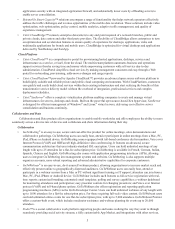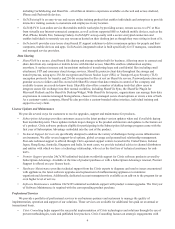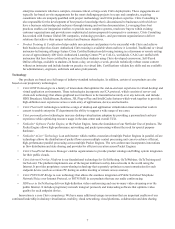Citrix 2012 Annual Report Download - page 19
Download and view the complete annual report
Please find page 19 of the 2012 Citrix annual report below. You can navigate through the pages in the report by either clicking on the pages listed below, or by using the keyword search tool below to find specific information within the annual report.15
• our, or a competitor's, announcement of new product or service enhancements or technologies that could replace or
shorten the life cycle of our existing product and service offerings.
We believe the demand for technology has and will continue to shift from the types of products and services we and our
competitors have sold in the past to a new generation of products we now offer. We cannot guarantee that our Mobile and
Desktop, Networking and Cloud and Collaboration and Data products will achieve the broad market acceptance by our channel
and strategic partners, customers and prospective customers necessary to generate significant revenue in the future. In addition,
we cannot guarantee that we will be able to respond effectively to technological changes or new product announcements by
others. If we experience material delays or sales shortfalls with respect to our new products and services or new releases of our
current products and services, those delays or shortfalls could have a material adverse effect on our business, results of
operations and financial condition.
In order to be successful, we must attract, engage, retain and integrate key employees, and failure to do so could have an
adverse effect on our ability to manage our business.
Our success depends, in large part, on our ability to attract, engage, retain, and integrate qualified executives and other
key employees throughout all areas of our business. Identifying, developing internally or hiring externally, training and
retaining highly-skilled managerial, technical, sales and services, finance and marketing personnel are critical to our future, and
competition for experienced employees can be intense. In order to attract and retain executives and other key employees in a
competitive marketplace, we must provide a competitive compensation package, including cash- and equity-based
compensation. If we do not obtain the stockholder approval needed to continue granting equity compensation in a competitive
manner, our ability to attract, retain, and motivate executives and key employees could be weakened. Failure to successfully
hire executives and key employees or the loss of any executives and key employees could have a significant impact on our
operations. Further, changes in our management team may be disruptive to our business, and any failure to successfully
integrate key new hires or promoted employees could adversely affect our business and results of operations.
Adverse changes in general global economic conditions could adversely affect our operating results.
As a globally operated company, we are subject to the risks arising from adverse changes in global economic and market
conditions. The worldwide economy underwent unprecedented turmoil in the past four years and continues to experience stock
market volatility, difficulties in the financial services sector, financial instability related to the sovereign debt situation in
Europe, reduced corporate profits and capital spending, and economic uncertainties. Although some of these conditions appear
to be abating, there are a number of mixed indicators, the severity and length of time these economic and market conditions
may persist is unknown, and the rate and pace of recovery in individual economies is also uncertain. The continuing uncertainty
about future global economic conditions could negatively impact our current and prospective customers and result in delays or
reductions in technology purchases. As a result, we could experience fewer orders, longer sales cycles, slower adoption of new
technologies and increased price competition, any of which could materially and adversely affect our business, results of
operations and financial condition. Adverse economic conditions also may negatively impact our ability to obtain payment for
outstanding debts owed to us by our customers or other parties with whom we do business.
Our Desktop Virtualization products are an alternative to the traditional way of managing desktops, and the growing market
for this line of products and services remains uncertain and may result in slower revenue growth than we have historically
experienced.
Our Desktop Virtualization products are based on an alternative technology platform, the success of which will depend on
organizations and customers perceiving technological and operational benefits and cost savings associated with adopting
desktop virtualization solutions. Although we have experienced success with this platform, the market for our Desktop
Virtualization products remains uncertain because customers may experience challenges in implementing desktop virtualization
as they may create complex deployments. In addition, our primary competition in desktop virtualization is the existing IT
practice of managing physical desktops as devices, and the success of our Desktop Virtualization products will depend on
information technology executives' continuing to rethink how desktops can be delivered more effectively and efficiently. To the
extent that there is slower adoption of desktop virtualization solutions, the revenue growth associated with our Desktop
Virtualization products may be slower than we have historically experienced, which could adversely affect our business, results
of operations and financial condition.
We anticipate that sales of our Desktop Virtualization products and related enhancements and upgrades will constitute a
majority of our revenue for the foreseeable future. Declines and variability in demand for our Desktop Virtualization products
could occur as a result of:
• new competitive product releases and updates to existing products;
• termination of our product offerings and enhancements;
























